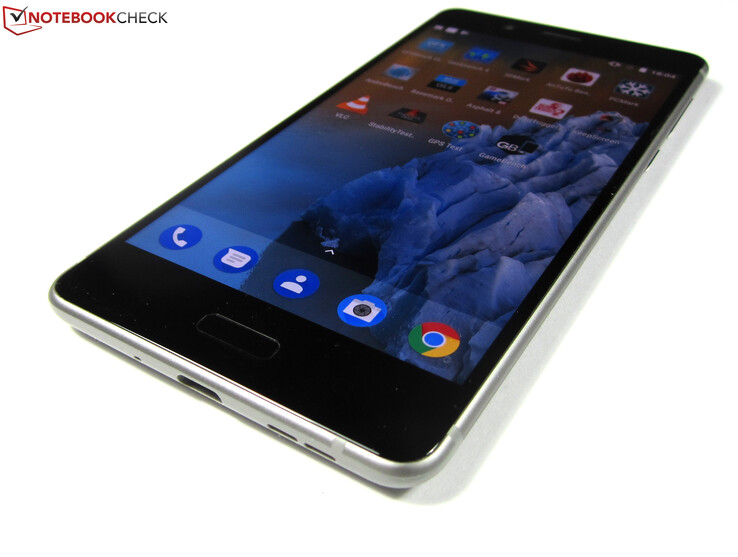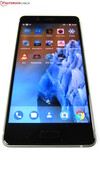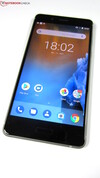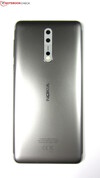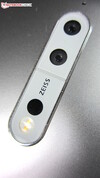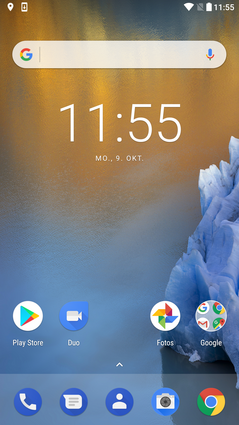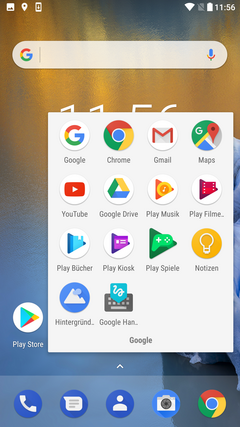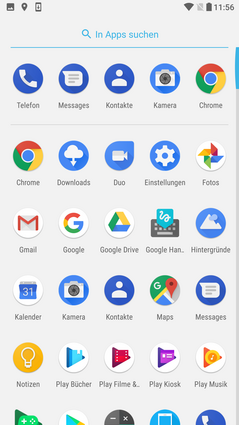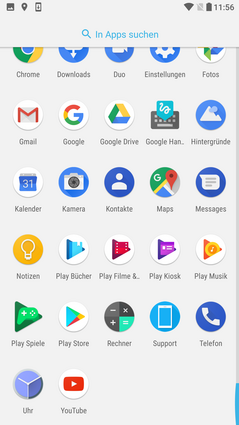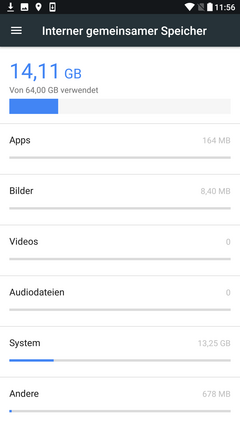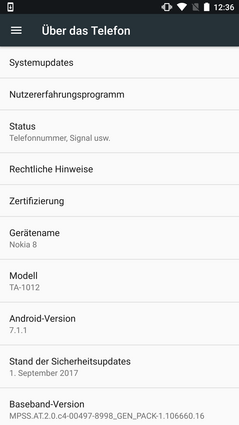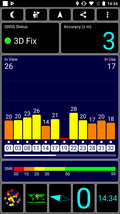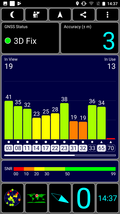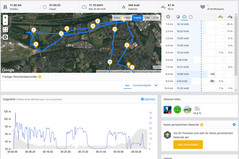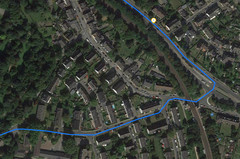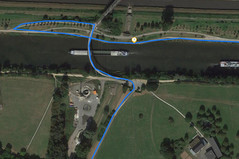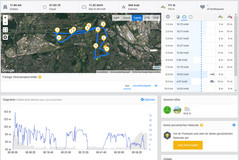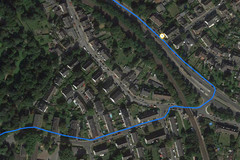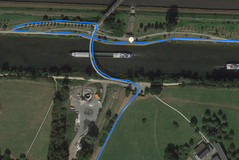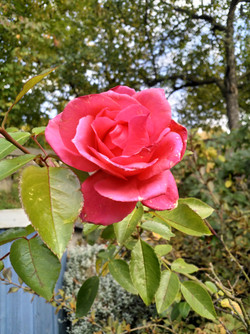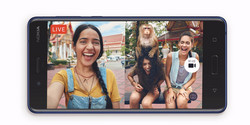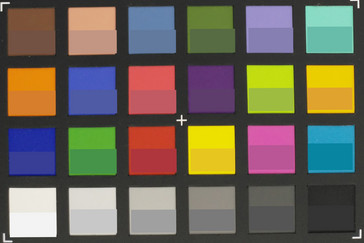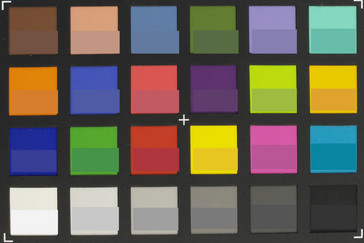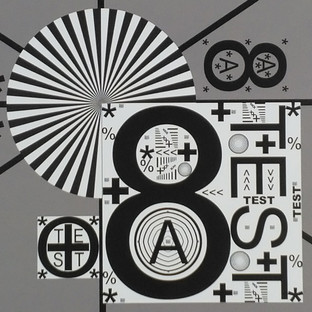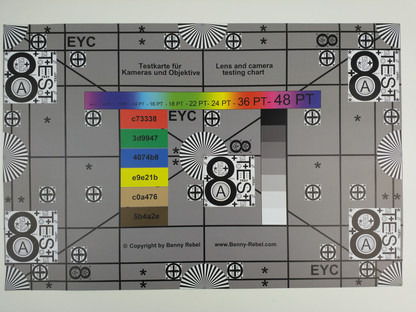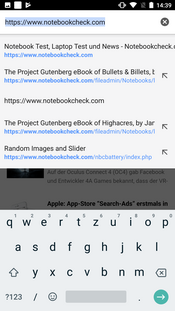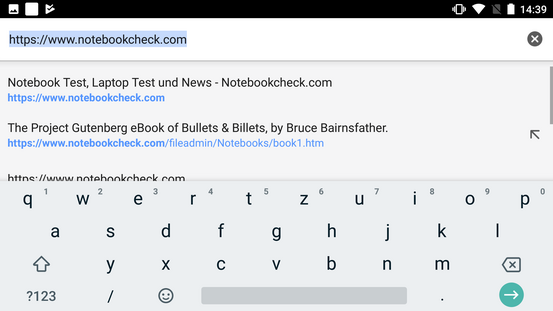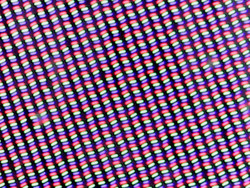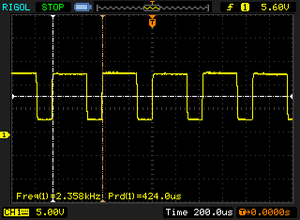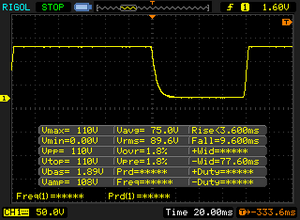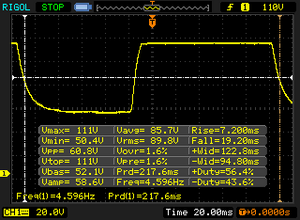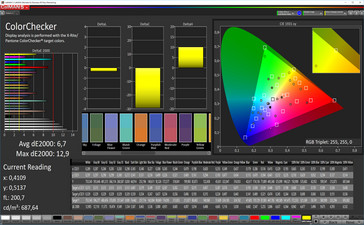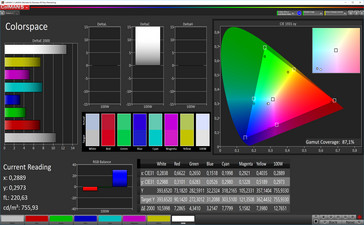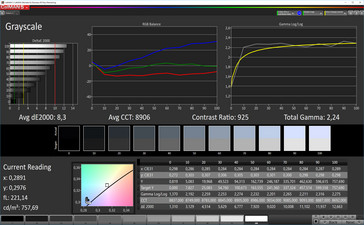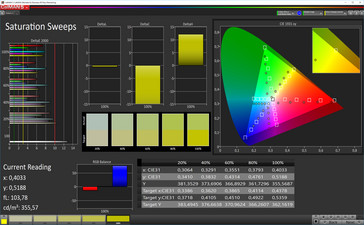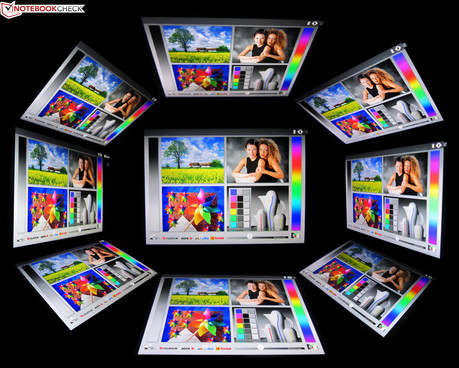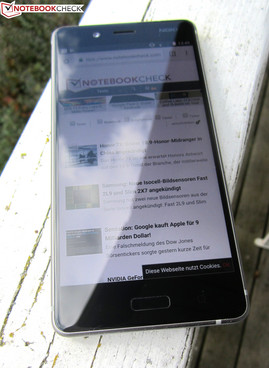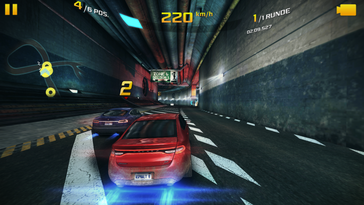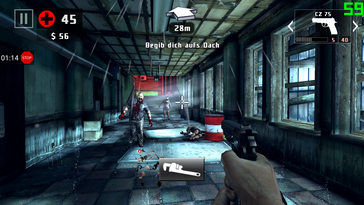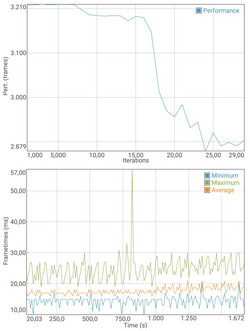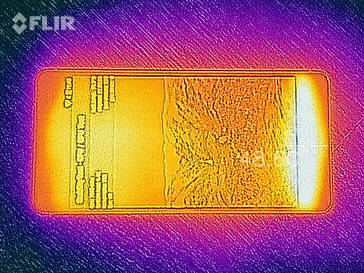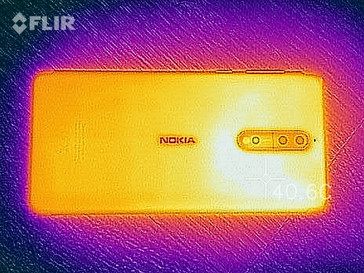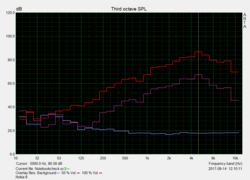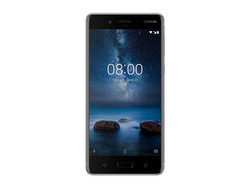Nokia 8 Smartphone Review

For the original German review, see here.
HMD Global has revived the brand Nokia with the three affordable entry-level Nokia 3, Nokia 5, and Nokia 6 handsets, and its comeback has been successful. However, it takes more than just a respectable result to permanently exist beside leaders such as Apple and Samsung. Thus, HMD Global has come up with something even better: The company - we will simply call it Nokia in the following - now also wants to infiltrate the premium-smartphone range with the Nokia 8.
Nokia packs all kinds of features into its upper-league smartphone to ensure the comeback in the premium range. It comes in an unusual form factor of 5.3-inches and has a resolution of 2560x1440 pixels (QHD). The specification list contains features like Qualcomm's high-end Snapdragon 835 SoC, 4 GB of RAM, 64 GB of storage, and the latest Android 7.1 in a pleasant-to-the-touch aluminum casing. Although the premium-range competition also offers a similar configuration, it does not have the dual-lens combination that is only found in the Nokia 8. The smartphone with an official price of 579 Euros (~$682; unofficially $565 in some US online retailers) can shoot photos and record videos at the same time using its webcam and primary camera. It can do this in a 4K resolution, as both cameras have a 13 MP sensor.
Our test reveals how well the Nokia 8 can stand up to the premium range. The smartphone competes against strong rivals such as the Apple iPhone 8, Samsung Galaxy S8, HTC U11, and OnePlus 5.
Case
According to the manufacturer, the Nokia 8 goes through a 40-level production process where it is milled from one piece of aluminum after which its surfaces are oxidized and polished. The much-used attribute "pleasant-to-the touch" very suitably summarizes the total impression - its feel can only be called superb.
The 7.9-millimeter slim smartphone chassis with elegantly rounded corners and edges is not completely made of metal. A plastic bezel inconspicuously hides the antennas and frames the speaker, microphone, USB port, and headset jack on the slim sides. The plastic covers match the casing color and feel almost just as good as the metal and glass surfaces. Nokia uses a 2.5D panel made of Corning Gorilla Glass 5 for the latter.
The back cover of our review sample with the matte casing color "Steel" feels pleasantly silky while the fingers still have a good grip on the handset. The second matte casing color is called "Tempered Blue". The Nokia 8 also comes with glossy back covers in colors called "Polished Blue" and "Polished Copper". They attract even more attention but are also more sensitive to fingerprints. The dual-camera is situated in the upper-third of the back cover and protrudes very slightly out of the casing. Thus, the smartphone does not rock significantly when placed on a table.
We end this chapter with a small point of criticism: The Nokia 8 is dust and splash-water resistant in compliance with the IP54 protection rating only. By contrast, the iPhone 8 remains protected for up to 30 minutes in a maximum water depth of one meter with its IP67 protection rating.
Connectivity
Qualcomm's high-end Snapdragon 835 SoC with an integrated Adreno 540 graphics chip alongside 4 GB of RAM and 64 GB storage create the performance basis of the Nokia 8. This should prevent performance bottlenecks in everyday use - now and in the near future.
"Uncompromising" is the keyword for the USB port. It is a USB 3.1 port Gen.1 Type-C. Thus, the smartphone can transmit up to 5 GBit/s. Although more is quite possible - the present maximum is 10 GBit/s with USB 3.1 Gen.2 - the available bandwidth should easily be enough for current application scenarios. In addition to Quick Charge (the corresponding Quick Charge power supply is included) the USB port also supports USB OTG, which allows connecting USB peripherals.
50 GB of the 64 GB storage capacity is available in a reset state or factory new condition. The storage can be expanded by up to 256 GB via a micro-SD card. However, the Nokia 8 does not support moving apps to the micro-SD card since the card can only be formatted as a portable storage. Thus, only photos and other media data can be stored on it. Our review sample has room for a nano-SIM card in the micro-SD card slot. The Nokia 8 is also available in a dual-SIM variant.
Software
Pure Android 7.1.1, i.e. a stock version without additional software, runs on the Nokia 8. Nokia has only adapted the camera app due to the camera module's special qualities - more about this in the camera chapter. However, the Android system remains unmodified in its core, which allows prompt security updates since the manufacturer does not have to make time-consuming and perhaps buggy modifications. The Android security patches were dated September 1, 2017 at test time (mid-October 2017), which is relatively up-to-date. Speaking of up-to-date: The Nokia 8 and the other new Nokia smartphones are to receive an update to Android 8.
Communication and GPS
The Nokia 8 comes with a well-configured communication module. It achieves a download speed of up to 450 MBit/s and an upload speed of up to 50 Mbit/s. Many LTE frequencies (band 1, 2, 3, 4, 5, 7, 8, 20, 28, 38, 40 and 41) are also present. Compared with the competition, this frequency coverage is only middling. Some rivals such as the Apple iPhone 8, OnePlus 5, and Samsung Galaxy S8 support twice if not three times as many LTE frequencies and can thus easily set up a connection in virtually every country in the world, while some will be missing with the Nokia 8. Furthermore, Gigabit LTE has become standard in many high-end smartphones, for example, in Apple's iPhone 8, HTC's U11, and Samsung's Galaxy S8.
Nokia has done a good job on paper in terms of near field communication with Wi-Fi 802.11 a/b/g/n/ac and Bluetooth 5.0 (which can first be used with Android 8). In practice, the strong rivals defeat the Nokia 8 smartphone in the comparison as it lacks the MIMO antenna technology. Although the Nokia 8 is everything but sluggish with a maximum of 235 MBit/s in transmit and receive when exchanging data with our Linksys EA8500 reference router via the 5 GHz frequency band, its Wi-Fi performance is in last place.
| Networking | |
| iperf3 transmit AX12 | |
| Samsung Galaxy S8 | |
| HTC U11 | |
| OnePlus 5 | |
| Apple iPhone 8 | |
| Nokia 8 | |
| iperf3 receive AX12 | |
| Apple iPhone 8 | |
| HTC U11 | |
| OnePlus 5 | |
| Samsung Galaxy S8 | |
| Nokia 8 | |
The Nokia 8 determines its position with GPS and GLONASS. The smartphone accomplished this with an accuracy of three meters both indoors and out in the test.
It presented the same accuracy on our roughly 12-kilometer bike test route. We also use Garmin's Edge 500 professional navigation system for comparison. In total, Garmin's navigation system is a little bit more accurate, but the Nokia 8 can provide tracking apps with very accurate information.
Telephony and Call Quality
The Nokia 8 delivered a decent call quality when telephoning and ensured clear communication at both ends of the line. However, the integrated noise suppression sometimes had difficulties transmitting our voice clearly in louder environments. Calls sounded satisfactory when using hands-free mode, but pleasant conversations require quiet surroundings here.
Cameras
The camera in the Nokia 8 is something special. A dual-camera module is situated on the smartphone's rear. The prestigious name Zeiss is beside it. However, the Finnish manufacturer does not reveal just how much Zeiss is really in the camera. It is a fact that the camera module consists of a monochrome and an RGB sensor, both with a resolution of 13 megapixels, a nominal aperture of f/2.0 and a pixel size of 1.12 µm. Features such as an optical image stabilizer and a phase detection autofocus alongside common software features like HDR, Bokeh, and a beauty mode are also present. The front camera also has a resolution of 13 megapixels and, like the primary camera, videos can be recorded in a maximum resolution of 4K at 30 frames per second.
The first special feature is seen in videos: The Nokia 8 uses Ozo 360 ° surround sound for videos recorded up to and including 4K. According to the manufacturer, only Hollywood moviemakers and music producers use this otherwise. The Nokia 8's three microphones capture a first-rate 3D sound in practice that really has a surround sound with headphones. However, this is not the only special feature.
Is "Bothie", the second special feature, a familiar term? Well, we had never heard it before we held the Nokia 8 in our hands. Bothie is something like a plural of selfie - but instead of staging just the user, a second person is simply put into the picture. However, the person does not have to sit, stand or lie beside the user like with a normal smartphone. The trick: The Nokia 8 can shoot a photo or record a video with both its webcam and primary camera simultaneously. The screen is divided equally in this so-called dual-sight mode and a camera view is displayed in each half - no other smartphone can do this to date. Possible applications are, for example, interviews where the interviewer and the interviewee are displayed at the same time. Matching this, Nokia equips its smartphone with a live broadcast function for streaming videos to Facebook or YouTube in a resolution of up to 4K.
3D audio, Bothie, 13 MP lens - does this make the Nokia 8 the perfect camera for photo and video fans? Yes and no: The smartphone's photos almost always look very good, are high in contrast, convince with a high degree of dynamics, and they reproduce even fine image details with clear structures. However, the camera tends to become extremely noisy in dark areas. When disregarding the special features, it is ultimately a good but not superb camera.
We performed further tests with the primary camera under defined light conditions. We examined the smartphone's color reproduction with the X-Rite ColorChecker Passport. Only the primary camera's RGB sensor was used for the first ColorChecker Passport photo. The second was taken with both the RGB and monochrome sensor. The color reproduction is always a bit too saturated since the white balance is slightly warmer. This results in high-contrast and colorful photos.
The Nokia 8 reproduces an almost overall sharp test chart when ignoring the minor sharpness decrease in the outermost edges. The smartphone does not have problems with color transitions. The reproduction only becomes slightly blurred in photos with dark lettering on a dark background.
Accessories and Warranty
The box contains a Quick Charge power supply, a charging/data cable, a headset, a quick-start guide, a leaflet with product and safety notes, and a tool for opening the SIM-card slot beside the smartphone. Nokia did not offer any special accessories for the Nokia 8 at test time.
The Nokia 8 comes with a 24-month warranty. The manufacturer limits the warranty on the battery, USB cable, headset, and charger to six months. This does not affect the two-year legal warranty. Please see our Guarantees, Return Policies & Warranties FAQ for country-specific information.
Input Devices and Handling
The Corning Gorilla Glass 5-protected screen of the Nokia 8 offers very good gliding properties and detects up to 10 fingers at the same time. Its responsiveness and accuracy do not give reason for complaint, either.
The fingerprint-sensor that Nokia incorporates into the home button delivers an equally good feedback. It is lowered slightly into the casing and can thus be found immediately. It unlocked the smartphone quickly and reliably in the test. The other two Android buttons are implemented as touch-sensitive areas that light up when touched.
The volume control and power buttons are situated on the casing's right. They have the same high-quality feel as the other components and please with accurate pressure points.
Google's standard Gboard keyboard app is preloaded. It can be replaced with another keyboard from the app store.
The Nokia 8 can display the QHD resolution of 2560x1440 pixels on its IPS panel. This equals an extremely high pixel density of 554 PPI on its 5.3-inch screen diagonal. The smartphone accomplishes another superlative in screen brightness.
With an average of 707.2 cd/m² on a white background and maximum screen brightness, the screen is very bright while it still manages a very homogeneous illumination (92%). Even up to 751 cd/m² is possible when distributing bright and dark areas evenly (APL50). However, Samsung's Galaxy S8 achieves almost 800 cd/m² here. These brightness rates easily make the Nokia 8 suitable for outdoor use.
Although the rivals cannot keep up here, they are not less suitable for everyday use. Apple's iPhone 8 (580 cd/m²) and Samsung's Galaxy S8 (564 cd/m²) also deliver excellent brightness rates. OnePlus' 5 also still shines very brightly with 431 cd/m². However, this is only average compared with the premium-range standards.
We determined a slight PWM-flickering in the test of the Nokia 8. However, this only occurs at a very high frequency of 2358 Hz and then only when the brightness is set to 17% or lower. Thus, sensitive users should not notice PWM-flickering in practice.
The Nokia 8's other image parameters are not quite as impressive as the brightness. With a comparatively high black level of 0.79 cd/m², the smartphone only manages a weak contrast ratio of 930:1. Apple's iPhone 8 and HTC's U11 do a better job here and reproduce considerably more vivid colors.
| |||||||||||||||||||||||||
Brightness Distribution: 92 %
Center on Battery: 735 cd/m²
Contrast: 930:1 (Black: 0.79 cd/m²)
ΔE ColorChecker Calman: 6.7 | ∀{0.5-29.43 Ø4.78}
ΔE Greyscale Calman: 8.3 | ∀{0.09-98 Ø5}
Gamma: 2.24
CCT: 8906 K
| Nokia 8 IPS, 2560x1440, 5.3" | OnePlus 5 AMOLED, 1920x1080, 5.5" | HTC U11 Super LCD5, 2560x1440, 5.5" | Samsung Galaxy S8 Super AMOLED, 2960x1440, 5.8" | Apple iPhone 8 IPS True Tone, 1334x750, 4.7" | |
|---|---|---|---|---|---|
| Screen | 24% | 29% | 23% | 38% | |
| Brightness middle (cd/m²) | 735 | 426 -42% | 482 -34% | 566 -23% | 604 -18% |
| Brightness (cd/m²) | 707 | 431 -39% | 472 -33% | 564 -20% | 580 -18% |
| Brightness Distribution (%) | 92 | 93 1% | 90 -2% | 94 2% | 91 -1% |
| Black Level * (cd/m²) | 0.79 | 0.33 58% | 0.44 44% | ||
| Contrast (:1) | 930 | 1461 57% | 1373 48% | ||
| Colorchecker dE 2000 * | 6.7 | 1.6 76% | 3.2 52% | 2.7 60% | 1.2 82% |
| Colorchecker dE 2000 max. * | 12.9 | 4.1 68% | 5.4 58% | 5.4 58% | 2.3 82% |
| Greyscale dE 2000 * | 8.3 | 1.7 80% | 2.2 73% | 3.1 63% | 1.6 81% |
| Gamma | 2.24 98% | 2.25 98% | 2.22 99% | 2.15 102% | 2.25 98% |
| CCT | 8906 73% | 6329 103% | 6581 99% | 6335 103% | 6688 97% |
| Color Space (Percent of AdobeRGB 1998) (%) | 81.57 | ||||
| Color Space (Percent of sRGB) (%) | 99.87 |
* ... smaller is better
Screen Flickering / PWM (Pulse-Width Modulation)
| Screen flickering / PWM detected | 2358 Hz | ≤ 17 % brightness setting | |
The display backlight flickers at 2358 Hz (worst case, e.g., utilizing PWM) Flickering detected at a brightness setting of 17 % and below. There should be no flickering or PWM above this brightness setting. The frequency of 2358 Hz is quite high, so most users sensitive to PWM should not notice any flickering. In comparison: 53 % of all tested devices do not use PWM to dim the display. If PWM was detected, an average of 8108 (minimum: 5 - maximum: 343500) Hz was measured. | |||
Display Response Times
| ↔ Response Time Black to White | ||
|---|---|---|
| 13.2 ms ... rise ↗ and fall ↘ combined | ↗ 3.6 ms rise | |
| ↘ 9.6 ms fall | ||
| The screen shows good response rates in our tests, but may be too slow for competitive gamers. In comparison, all tested devices range from 0.1 (minimum) to 240 (maximum) ms. » 33 % of all devices are better. This means that the measured response time is better than the average of all tested devices (20.2 ms). | ||
| ↔ Response Time 50% Grey to 80% Grey | ||
| 26.4 ms ... rise ↗ and fall ↘ combined | ↗ 7.2 ms rise | |
| ↘ 19.2 ms fall | ||
| The screen shows relatively slow response rates in our tests and may be too slow for gamers. In comparison, all tested devices range from 0.165 (minimum) to 636 (maximum) ms. » 35 % of all devices are better. This means that the measured response time is better than the average of all tested devices (31.6 ms). | ||
The spectrophotometer and CalMAN analysis software reveal more shortcomings. The color temperature of 8906 K clearly shifts the reproduction into blue and thus looks much too cool. The Nokia 8 does not do a very accurate job in color and grayscale reproduction. DeltaE shifts of <3 are not visible for the viewer - a hurdle that the smartphone does not take in either colors (DeltaE 6.7) or grayscales (DeltaE 8.3). Thus, the Nokia 8 cannot compete with its rivals that all deliver exemplary rates here.
The Nokia 8 is very outdoor suitable thanks to its extremely high brightness reserves. It also presents a well-recognizable image when the light is too bright for other smartphones. However, the user will have to look for a shaded place in direct sunlight even with the Nokia 8. As typical for IPS, the screen content is still well-legible also in flatter angles and then only looks a bit darker at most.
Performance
Qualcomm's high-end Snapdragon 835 SoC, which is the successor of Qualcomm's Snapdragon 821 SoC, operates in the Nokia 8. It is one of the first smartphone chips that are built in a 10 nm manufacturing process. Its eight processing cores are divided into two clusters; one for high performance with four Kryo 280 cores and a maximum clock of 2.45 GHz and another energy-saving cluster with four more Kryo 280 cores and a clock speed of up to 1.9 GHz. The Adreno 540 graphics unit is integrated into the SoC. It displays even very demanding games in high resolutions smoothly.
The CPU-GPU combination can fall back on 4 GB of RAM and turns the Nokia 8 into a very fast smartphone in everyday use. Its extremely good system performance in the synthetic benchmarks (see PCMark) is particularly impressive. In total, it is roughly on par with the also very powerful HTC U11, OnePlus 5 and Samsung Galaxy S8. Apple's iPhone 8 is in a class of its own.
| AnTuTu v6 - Total Score (sort by value) | |
| Nokia 8 | |
| OnePlus 5 | |
| HTC U11 | |
| Samsung Galaxy S8 | |
| Apple iPhone 8 | |
| PCMark for Android | |
| Work performance score (sort by value) | |
| Nokia 8 | |
| OnePlus 5 | |
| HTC U11 | |
| Samsung Galaxy S8 | |
| Work 2.0 performance score (sort by value) | |
| Nokia 8 | |
| OnePlus 5 | |
| HTC U11 | |
| Samsung Galaxy S8 | |
| Geekbench 4.4 | |
| 64 Bit Single-Core Score (sort by value) | |
| Nokia 8 | |
| OnePlus 5 | |
| HTC U11 | |
| Samsung Galaxy S8 | |
| Apple iPhone 8 | |
| 64 Bit Multi-Core Score (sort by value) | |
| Nokia 8 | |
| OnePlus 5 | |
| HTC U11 | |
| Samsung Galaxy S8 | |
| Apple iPhone 8 | |
| Compute RenderScript Score (sort by value) | |
| OnePlus 5 | |
| HTC U11 | |
| Samsung Galaxy S8 | |
| 3DMark | |
| 1280x720 offscreen Ice Storm Unlimited Score (sort by value) | |
| Nokia 8 | |
| OnePlus 5 | |
| HTC U11 | |
| Samsung Galaxy S8 | |
| Apple iPhone 8 | |
| 1280x720 offscreen Ice Storm Unlimited Graphics Score (sort by value) | |
| Nokia 8 | |
| OnePlus 5 | |
| HTC U11 | |
| Samsung Galaxy S8 | |
| Apple iPhone 8 | |
| 1280x720 offscreen Ice Storm Unlimited Physics (sort by value) | |
| Nokia 8 | |
| OnePlus 5 | |
| HTC U11 | |
| Samsung Galaxy S8 | |
| Apple iPhone 8 | |
| 2560x1440 Sling Shot OpenGL ES 3.0 (sort by value) | |
| Nokia 8 | |
| OnePlus 5 | |
| HTC U11 | |
| Samsung Galaxy S8 | |
| 2560x1440 Sling Shot OpenGL ES 3.0 Graphics (sort by value) | |
| Nokia 8 | |
| OnePlus 5 | |
| HTC U11 | |
| Samsung Galaxy S8 | |
| 2560x1440 Sling Shot OpenGL ES 3.0 Physics (sort by value) | |
| Nokia 8 | |
| OnePlus 5 | |
| HTC U11 | |
| Samsung Galaxy S8 | |
| Apple iPhone 8 | |
| 2560x1440 Sling Shot Extreme (ES 3.1) (sort by value) | |
| Nokia 8 | |
| OnePlus 5 | |
| HTC U11 | |
| Samsung Galaxy S8 | |
| Apple iPhone 8 | |
| 2560x1440 Sling Shot Extreme (ES 3.1) Graphics (sort by value) | |
| Nokia 8 | |
| OnePlus 5 | |
| HTC U11 | |
| Samsung Galaxy S8 | |
| Apple iPhone 8 | |
| 2560x1440 Sling Shot Extreme (ES 3.1) Physics (sort by value) | |
| Nokia 8 | |
| OnePlus 5 | |
| HTC U11 | |
| Samsung Galaxy S8 | |
| Apple iPhone 8 | |
| GFXBench (DX / GLBenchmark) 2.7 | |
| T-Rex Onscreen (sort by value) | |
| Nokia 8 | |
| OnePlus 5 | |
| HTC U11 | |
| Samsung Galaxy S8 | |
| Apple iPhone 8 | |
| 1920x1080 T-Rex Offscreen (sort by value) | |
| Nokia 8 | |
| OnePlus 5 | |
| HTC U11 | |
| Samsung Galaxy S8 | |
| Apple iPhone 8 | |
| GFXBench 3.0 | |
| on screen Manhattan Onscreen OGL (sort by value) | |
| Nokia 8 | |
| OnePlus 5 | |
| HTC U11 | |
| Samsung Galaxy S8 | |
| Apple iPhone 8 | |
| 1920x1080 1080p Manhattan Offscreen (sort by value) | |
| Nokia 8 | |
| OnePlus 5 | |
| HTC U11 | |
| Samsung Galaxy S8 | |
| Apple iPhone 8 | |
| GFXBench 3.1 | |
| on screen Manhattan ES 3.1 Onscreen (sort by value) | |
| Nokia 8 | |
| OnePlus 5 | |
| HTC U11 | |
| Samsung Galaxy S8 | |
| Apple iPhone 8 | |
| 1920x1080 Manhattan ES 3.1 Offscreen (sort by value) | |
| Nokia 8 | |
| OnePlus 5 | |
| HTC U11 | |
| Samsung Galaxy S8 | |
| Apple iPhone 8 | |
| GFXBench | |
| on screen Car Chase Onscreen (sort by value) | |
| Nokia 8 | |
| OnePlus 5 | |
| HTC U11 | |
| Samsung Galaxy S8 | |
| 1920x1080 Car Chase Offscreen (sort by value) | |
| Nokia 8 | |
| OnePlus 5 | |
| HTC U11 | |
| Samsung Galaxy S8 | |
Apple's iPhone 8 dominates in the browser benchmarks and shows the Android rivals their limits. However, none of the smartphones provide reason for complaint. The Nokia 8 also loads websites very quickly and displays sophisticated HTML5 browser games, such as Ouigo (letsplay.ouigo.com), smoothly.
| JetStream 1.1 - Total Score | |
| Apple iPhone 8 | |
| OnePlus 5 (Chrome 59) | |
| HTC U11 (Chrome 58) | |
| Samsung Galaxy S8 (Samsung Browser 5.2) | |
| Nokia 8 (Chrome 61.0.3163.98) | |
| Octane V2 - Total Score | |
| Apple iPhone 8 | |
| Samsung Galaxy S8 (Samsung Browser 5.2) | |
| OnePlus 5 (Chrome 59) | |
| HTC U11 (Chrome 58) | |
| Nokia 8 (Chrome 61.0.3163.98) | |
| Mozilla Kraken 1.1 - Total | |
| Nokia 8 (Chrome 61.0.3163.98) | |
| HTC U11 (Chrome 58) | |
| OnePlus 5 (Chrome 59) | |
| Samsung Galaxy S8 (Samsung Browser 5.2) | |
| Apple iPhone 8 | |
| WebXPRT 2015 - Overall | |
| Apple iPhone 8 | |
| Samsung Galaxy S8 (Samsung Browser 5.2) | |
| Nokia 8 (Chrome 61.0.3163.98) | |
| HTC U11 (Chrome 58) | |
| OnePlus 5 (Chrome 59) | |
* ... smaller is better
One of the presently fastest UFS 2.1 storage devices on the market is in the Nokia 8, and this is seen impressively in Androbench. The 64 GB storage can be expanded by up to 256 GB via a micro-SD card. We test the micro-SD slot's speed with our Toshiba Exceria Pro M501 reference card (read max. 270 MB/s, write max 150 MB/s). The competition's results are only average compared with the maximum transfer speed of 76.9 MB/s.
| Nokia 8 | OnePlus 5 | HTC U11 | Samsung Galaxy S8 | |
|---|---|---|---|---|
| AndroBench 3-5 | 10% | 67% | -1% | |
| Sequential Read 256KB (MB/s) | 680 | 748 10% | 717 5% | 793 17% |
| Sequential Write 256KB (MB/s) | 199.1 | 201.5 1% | 206.4 4% | 193.2 -3% |
| Random Read 4KB (MB/s) | 145.7 | 141 -3% | 91.4 -37% | 127.2 -13% |
| Random Write 4KB (MB/s) | 14.57 | 19.3 32% | 80 449% | 15.25 5% |
| Sequential Read 256KB SDCard (MB/s) | 76.8 ? | 68.8 ? -10% | 63.9 ? -17% | |
| Sequential Write 256KB SDCard (MB/s) | 51.7 ? | 46.25 ? -11% | 53.5 ? 3% |
Games
Buyers of the Nokia 8 will also be purchasing a gaming machine. Not only because the position and motion sensors function impeccably - this is the case in virtually every smartphone. The powerful SoC with its high-end Adreno 540 graphics chip will make players happy since they allow playing every up-to-date game smoothly in maximum details. We installed Asphalt 8: Airborne and Dead Trigger 2 for testing purposes. Both games have high hardware requirements, and both achieve the maximum possible frame rate in maximum details. This is limited to 30 FPS in Asphalt 8: Airborne and to 60 FPS in Dead Trigger 2.
| Dead Trigger 2 | |||
| Settings | Value | ||
| high | 60 fps | ||
| Asphalt 8: Airborne | |||
| Settings | Value | ||
| high | 30 fps | ||
| very low | 30 fps | ||
Emissions
Temperature
When idling, the warmest spot on the Nokia 8 is just below 40 °C. Its highest rate of 45.1 °C during load is also within an absolutely uncritical thermal range.
The smartphone does not struggle with high temperatures under the hood even if the GFXBench Manhattan ES 3.1 test scenario shows a completely different picture at first glance. The benchmark runs 30 times in succession and the frame rates remain at approximately the same level for half the test. They then drop rapidly and settle to a lower level until the end. However, this throttling is so slight that it will not be noticed in everyday use.
(-) The maximum temperature on the upper side is 45.1 °C / 113 F, compared to the average of 35.2 °C / 95 F, ranging from 21.9 to 247 °C for the class Smartphone.
(+) The bottom heats up to a maximum of 38.3 °C / 101 F, compared to the average of 34 °C / 93 F
(±) In idle usage, the average temperature for the upper side is 34.3 °C / 94 F, compared to the device average of 32.9 °C / 91 F.
Speaker
Unlike the video recordings that receive a first-rate sound thanks to Ozo 360 ° surround, the speaker is just standard. A mono speaker is situated on the smartphone's lower edge. It achieves an impressive maximum volume of up to 91.6 dB(A), but it delivers a thin, very treble-heavy sound with virtually no audible bass. The speaker provides a satisfactory sound for playing YouTube videos or making calls via hands-free mode. The sound improves quite a bit when using the included headset.
Nokia 8 audio analysis
(+) | speakers can play relatively loud (91.6 dB)
Bass 100 - 315 Hz
(-) | nearly no bass - on average 26.6% lower than median
(+) | bass is linear (5.9% delta to prev. frequency)
Mids 400 - 2000 Hz
(±) | reduced mids - on average 6.7% lower than median
(+) | mids are linear (5.6% delta to prev. frequency)
Highs 2 - 16 kHz
(±) | higher highs - on average 8% higher than median
(+) | highs are linear (5% delta to prev. frequency)
Overall 100 - 16.000 Hz
(±) | linearity of overall sound is average (21.9% difference to median)
Compared to same class
» 44% of all tested devices in this class were better, 8% similar, 48% worse
» The best had a delta of 11%, average was 35%, worst was 134%
Compared to all devices tested
» 62% of all tested devices were better, 7% similar, 31% worse
» The best had a delta of 4%, average was 24%, worst was 134%
Apple iPhone 8 audio analysis
(±) | speaker loudness is average but good (78.4 dB)
Bass 100 - 315 Hz
(±) | reduced bass - on average 14.6% lower than median
(±) | linearity of bass is average (9.2% delta to prev. frequency)
Mids 400 - 2000 Hz
(+) | balanced mids - only 4.3% away from median
(+) | mids are linear (4.2% delta to prev. frequency)
Highs 2 - 16 kHz
(±) | higher highs - on average 5.1% higher than median
(+) | highs are linear (4.7% delta to prev. frequency)
Overall 100 - 16.000 Hz
(±) | linearity of overall sound is average (18.2% difference to median)
Compared to same class
» 17% of all tested devices in this class were better, 8% similar, 74% worse
» The best had a delta of 11%, average was 35%, worst was 134%
Compared to all devices tested
» 38% of all tested devices were better, 8% similar, 54% worse
» The best had a delta of 4%, average was 24%, worst was 134%
Samsung Galaxy S8 audio analysis
(+) | speakers can play relatively loud (82.4 dB)
Bass 100 - 315 Hz
(-) | nearly no bass - on average 22.1% lower than median
(±) | linearity of bass is average (11.7% delta to prev. frequency)
Mids 400 - 2000 Hz
(±) | higher mids - on average 5% higher than median
(+) | mids are linear (4.3% delta to prev. frequency)
Highs 2 - 16 kHz
(+) | balanced highs - only 3.7% away from median
(+) | highs are linear (6.7% delta to prev. frequency)
Overall 100 - 16.000 Hz
(±) | linearity of overall sound is average (21.8% difference to median)
Compared to same class
» 44% of all tested devices in this class were better, 8% similar, 48% worse
» The best had a delta of 11%, average was 35%, worst was 134%
Compared to all devices tested
» 61% of all tested devices were better, 7% similar, 32% worse
» The best had a delta of 4%, average was 24%, worst was 134%
Frequency diagram comparison (checkboxes above can be turned on/off!)
Energy Management
Power Consumption
The Nokia 8 is just as economic as its rivals in power consumption and places itself pretty much in the middle of the test field during load (4.65 watts). The smartphone has the highest consumption of almost 10 watts only in the rather unrealistic full load scenario.
| Off / Standby | |
| Idle | |
| Load |
|
Key:
min: | |
| Nokia 8 3090 mAh | OnePlus 5 3300 mAh | HTC U11 3000 mAh | Samsung Galaxy S8 3000 mAh | Apple iPhone 8 1821 mAh | |
|---|---|---|---|---|---|
| Power Consumption | 9% | 11% | 33% | 29% | |
| Idle Minimum * (Watt) | 0.86 | 0.73 15% | 0.73 15% | 0.78 9% | 0.54 37% |
| Idle Average * (Watt) | 2.13 | 1.44 32% | 1.96 8% | 1.1 48% | 1.63 23% |
| Idle Maximum * (Watt) | 2.16 | 1.5 31% | 1.98 8% | 1.16 46% | 1.67 23% |
| Load Average * (Watt) | 4.65 | 6.91 -49% | 4.82 -4% | 4.15 11% | 2.74 41% |
| Load Maximum * (Watt) | 9.99 | 8.51 15% | 7.15 28% | 5.12 49% | 7.78 22% |
* ... smaller is better
Battery Runtime
Nokia has provided its upper-league smartphone with a good battery capacity. The Nokia 8 runs for almost 8 hours in the realistic Wi-Fi test (websites are opened every 30 seconds using a screen brightness of 150 cd/m²). The smartphone plays the H.264 video for over 12:13 hours. Among the rivals, only Samsung's Galaxy S8 lasts a bit longer. In total, the differences are too low for speaking of an advantage or disadvantage, perhaps with exception of HTC's U11.
The Nokia 8 supports Quick Charge 3 and is completely recharged in approximately 1:30 hours when connected to an outlet in a turned-off state.
| Nokia 8 3090 mAh | OnePlus 5 3300 mAh | HTC U11 3000 mAh | Samsung Galaxy S8 3000 mAh | Apple iPhone 8 1821 mAh | |
|---|---|---|---|---|---|
| Battery runtime | -8% | -19% | 10% | -5% | |
| Reader / Idle (h) | 25.1 | 25.6 2% | 20.8 -17% | 27.8 11% | 27.2 8% |
| H.264 (h) | 12.2 | 10.4 -15% | 8.3 -32% | 12.9 6% | 11.6 -5% |
| WiFi v1.3 (h) | 10.8 | 8.6 -20% | 9.3 -14% | 12 11% | 9.8 -9% |
| Load (h) | 4 | 4.1 3% | 3.5 -12% | 4.4 10% | 3.4 -15% |
Pros
Cons
Verdict
The Nokia 8 scores with its superbly built aluminum casing and a very bright, 5.3-inch QHD screen. It also earns sympathy points with its high-end Qualcomm Snapdragon 835 SoC. This, alongside 4 GB of RAM and the swift Adreno 540 pixel accelerator, always ensures a fast operating speed. Then there is the long battery life, fast recharging via Quick Charge 3.0 and even a real unique selling point with the "Bothie": The 13 MP camera in the Nokia 8 can simultaneously shoot photos and record videos with its webcam and primary camera in a kind of split-screen mode and creates a quasi double-selfie. This also functions in the 4K resolution in videos and is accompanied by a great Ozo 360 ° surround sound thanks to three microphones.
With the Nokia 8, HMD Global offers a premium-range smartphone that is far up front in almost every aspect and thus rightly places itself in the orbit of leaders such as Apple's iPhone 8 or Samsung's Galaxy S8. However, it does not quite measure up to the strong rivals.
When disregarding the cameras' innovative special mode that will likely appeal to creative users, the Nokia 8 is still a very good smartphone. However, minor discrepancies prevent it from reaching a higher rank. For example, an IP67 protection rating that protects the handset from ingress of water and dust can be expected from a premium-range device. We would have also wished that the fast LTE module would support more frequencies. The one or other missing frequency band prevents the Nokia 8 from being a real globetrotter. The Wi-Fi transmission speed is not very exhilarating compared with the premium-range competition, either.
In addition to the single-SIM variant that we tested, Nokia also offers the 8 in a version with a dual-SIM slot. Furthermore, a model with 128 GB of storage is to be launched soon. However, information concerning this could not be found on Nokia's German-language website at test time.
Nokia 8
- 10/19/2017 v6 (old)
Manuel Masiero




